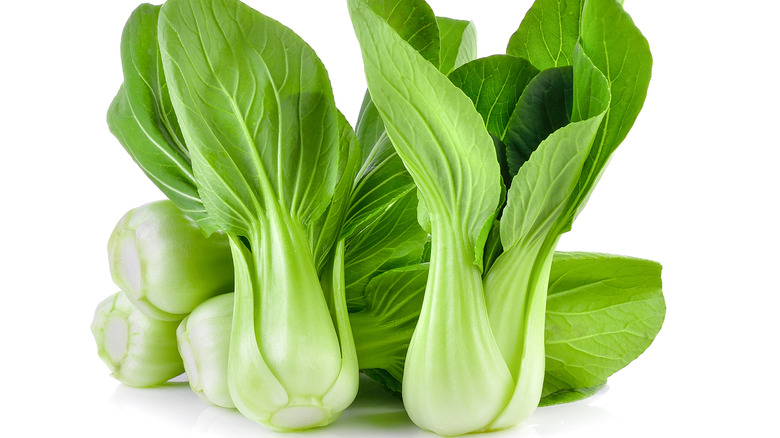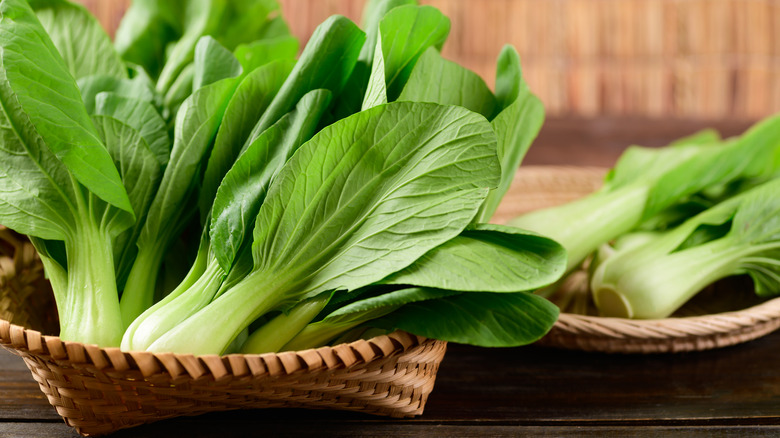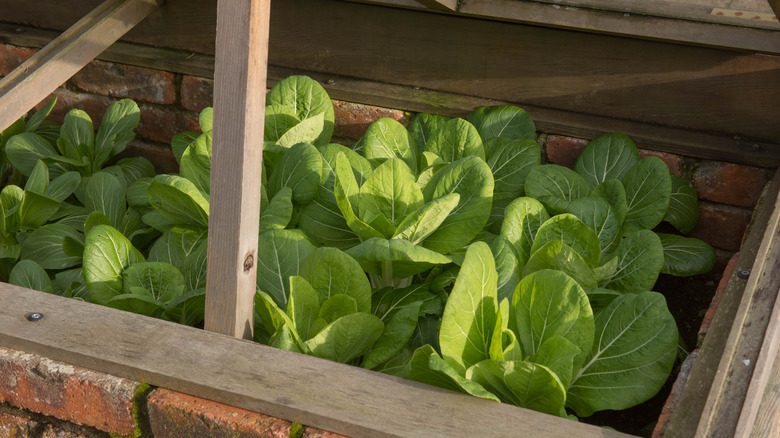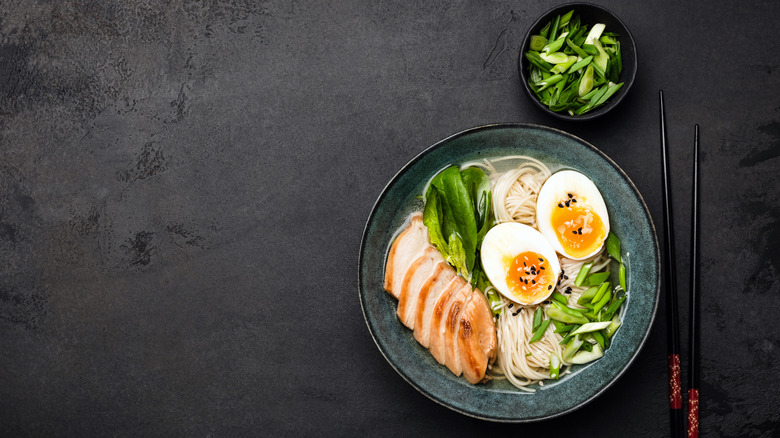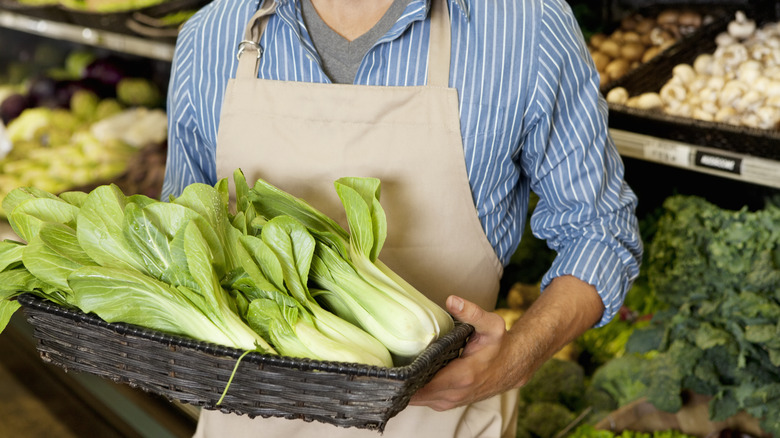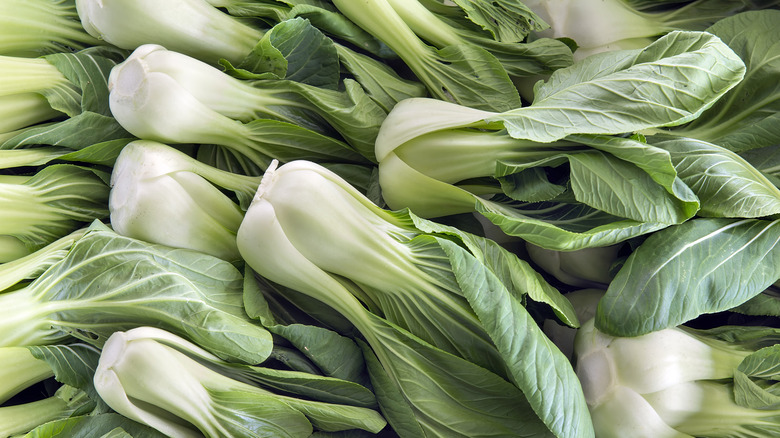What Is Bok Choy And Which Part Can You Eat?
Have you ever tried bok choy? If you like Chinese food, chances are you're familiar with this leafy green vegetable. Also known as Chinese cabbage, bok choy shows up in a variety of stir frys, soups, and dumpling fillings (via The Spruce Eats).
A member, as cited above, of the cabbage family, bok choy (brassica rapa chinensis) is native to the Yangtze River Delta in China and has likely been cultivated at least since the fifth century (via Gardener's Path). Over these many centuries, bok choy has taken on a variety of shapes and sizes, from small, bulb-shaped baby bok choy with bright green ribs and leaves, to a larger, sturdier variety with white ribs and dark green leaves (via The Woks of Life). Today, the U.S. supply of the vegetable is mainly imported from Mexico, but some are grown in California, Arizona, and Texas (via Houstonia Magazine).
Let's take a closer look at bok choy, and learn what it tastes like, where to buy it, and how to cook with it.
What does bok choy taste like?
A leafy green vegetable whose form is a compact head, all varieties of bok choy have wide leaves with a substantial rib running through the leaf. Similar in taste to green cabbage or Napa cabbage, bok choy is generally mild, and The Spruce Eats notes that both the ribs and the leaves can be eaten.
Bok choy can be eaten raw or cooked. When eaten raw, it's juicy and a bit mustardy in taste, a perfect choice for salads and slaws such as an apple and bok choy salad with carrots and onions (via Epicurious). When cooked, bok choy tastes earthy and slightly sweet (via Gardener's Path). It's ideal for including in stir frys, soups, in dumpling fillings and in meatball mixes, and straight up roasted (via The Spruce Eats). Because bok choy is so mild in flavor, it can also be blended into smoothies and green juices (via The Blender Girl).
How to clean bok choy
Bok choy is grown in the ground, and as its tightly packed leaves and stems develop and push up through the earth, those layers of leaves and stems retain a lot of soil (via Cook's Illustrated). It's essential to clean all varieties of bok choy thoroughly before cooking.
To clean baby bok choy, halve them lengthwise, cutting down through the core, which will hold each half together. Place the halves in a large bowl or in a stoppered sink, then fill with plenty of water, Cook's Illustrated explains. Swish the vegetable around and then let it sit for a few minutes; the dirt and grit will fall to the bottom of the bowl or sink. Carefully lift the bok choy from the bowl or sink, rinse away the dirt, then repeat this process one or two times until the vegetable is totally clean. Then, run it through a salad spinner to remove the excess moisture.
For larger varieties of bok choy, you can separate each leaf from the vegetable's core and rinse them under running water before drying on a towel (via Jessica Gavin). Or, if the recipe calls for all the bok choy to be chopped, you can chop it and then rinse it in several changes of water as described above. Just make sure to keep the rib portions separate from the leaf portions (more on this in a second). You can run the chopped bok choy through a salad spinner to dry it.
How to cook with bok choy
When it comes to bok choy recipes, the sky is truly the limit. As mentioned above, bok choy can be utilized both raw or cooked, in a large variety of recipes that are both Asian-inspired and not.
One important factor to pay attention to when cooking bok choy is the difference between the ribs and the leaves. As with similar vegetables such as chard, boy choy's stems or ribs take a bit longer to cook than the leaves, which are mostly water. Cook's Illustrated suggests separating the ribs from the leaves after washing; when proceeding with recipes such as stir frys and soups, add the ribs to the pan or pot about five minutes before adding the leaves.
Bok choy will be at home in a stir fry with shrimp or chicken; tossed into a soup alongside ginger and noodles; minced into a meatball mix, or into a pork dumpling filling. For a simple side dish alongside a basic starch and protein, just sauté some in a pan with the aromatics of your choice (via Inspired Taste).
Where to buy bok choy
While you're likely to find regular bok choy — the large heads with white ribs and dark green leaves — as well as baby bok choy in any large supermarket, your best bet for exploring the different varieties is to head to your local Asian grocery. There, in addition to those two varieties, you might find smooth Shanghai bok choy in both its baby and larger sizes, as well as dwarf bok choy, which has white stems and dark green, curly leaves (via The Woks of Life).
When selecting bok choy, look for firm, unbruised stems with bright green leaves that haven't yellowed, browned, or torn. Likewise, avoid any vegetable whose stalks have brown spots; that means it's too old (via Cook's Illustrated).
At home, Cook's Illustrated suggests storing bok choy in a loosely sealed plastic bag in the refrigerator for two to three days. Never wash it before storing; the additional moisture will cause it to deteriorate faster.
Is bok choy healthy?
One cup of raw shredded bok choy, per Healthline, contains 9 calories, one gram of protein, zero grams of fat, two grams of carbohydrates, one gram of fiber, and one gram of sugar.
And if you love bok choy, you're in luck: Healthline notes this vegetable is a powerhouse of fiber, vitamins, and minerals, meaning there's no reason not to include it in your diet wherever possible. It's an excellent source of the flavonoid quercetin, which can help reduce inflammation in the body and might help reduce the risk of developing chronic health issues such as heart disease and diabetes (via VeryWellFit).
Bok choy is not only high in vitamin C, it's also notable for its variety of cancer-fighting compounds, including beta-carotene, folate, and selenium. High in the minerals potassium, magnesium, and calcium, bok choy intake can help lower blood pressure (via Healthline). Sounds pretty darn healthy to us!
